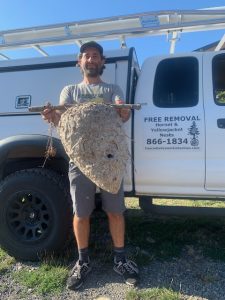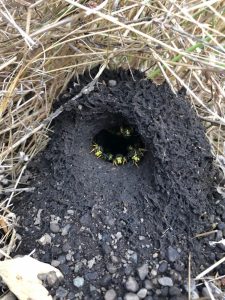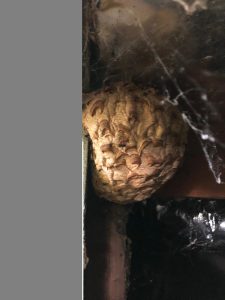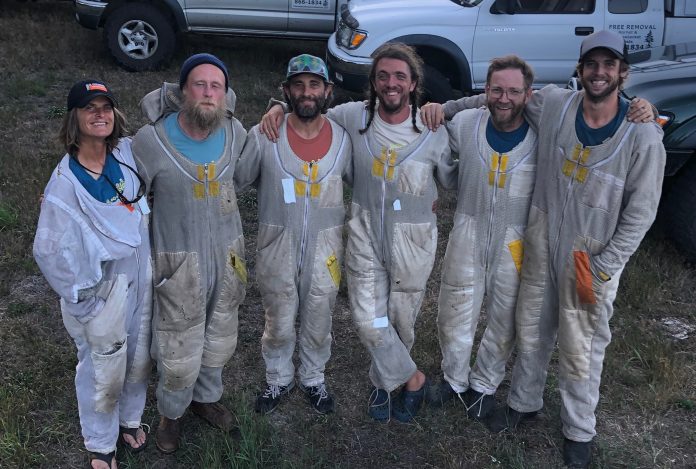Western yellow jackets seem to have a knack for positioning themselves in the worst possible location. Take, for example, the recent case of a large nest right above the sliding glass door that led to a woman’s bedroom. Not only was she attacked every time she stepped outside, so were her children, dogs and cats. “Her son got stung,” says Zach Techner, owner of Cascadia Venom Collection. “It was a bad situation.”

Fortunately, it was also a problem that Techner is used to solving. From late spring to early fall, he and his team visit hundreds of local homes and businesses, safely extracting hornet and yellow jacket nests with a specialized vacuum and trap. At the end of the season, he delivers the insects to labs where their venom is used to develop allergy testing products and immunotherapy medication – all at no cost to customers.
In this instance, he observed the yellow jackets going in and out of the wall near the glass door and was able to open the bird blocking and suck them out. “She can go out and use her back porch again,” says Techner.
Ground nesting yellow jacket and bald-faced hornet seasons kick into high gear in July and they remain active until the first rainy weather hits in early October, creating challenges for anyone who comes upon a nest. Usually, people find them the hard way. “99 percent of the nests that we get are in real problem areas, right around people’s houses,” Techner shares.
Bald-faced hornets create exposed nests that resemble big paper balls, most of which are between the size of a cantaloupe and a watermelon by early August. Approximately 75 percent of those are found in rhododendron bushes, with the other 25 percent split between eaves or in other types of shrubs or bushes such as scotch broom, blueberry plants and madrone trees. “These hornets are three to four times as large as yellow jackets and their sting is about 20 times more painful than a yellow jacket’s,” says Techner.
Should you discover a nest on your property, the most important thing is to remain calm, he maintains. “By the time you’ve found it, that nest has already been there for months. It may seem like an emergency, but just know that they’re not aggressive per se, but very defensive of their nests. Once you know where their nest is, you can stay safe by staying away from them.”

Unlike bald-faced hornets, ground-nesting yellow jackets establish their homes under the earth’s surface with the unfortunate result that most people discover them either by walking over a nest or disturbing one through mowing or weed whacking. To distinguish between yellow jacket habitats and those of harmless native bees, Techner recommends observing where they go. The latter nest in aggregate colonies with hundreds of holes in the ground, especially in sandy soil. “They’re native pollinators and they’re really sweet,” he says. “They’re not aggressive.” Yellow jackets, however, can be identified by a defined, distinct hole in the ground about the size of a silver dollar. If the nest is under a bush, they’ll chew a tunnel through it.
As with hornets, once you’ve identified a nest’s location, the best defense is to stay away. “Avoid mowing the lawn or weed whacking close to them because that can vibrate the nest,” Techner advises. “Give them some space and they’re not going to attack you.”
One key point: don’t treat any nests with chemicals or water. If you do, it will render them useless for any medicinal or research value purposes.
Not every nest can be removed; in situations that would require destroying part of a wall or roof to create access, it’s not worth the damage, says Techner. However, even then his equipment can collect between 80 and 90 percent of the worker insects, reducing the chance of structural damage and halting the nest’s growth.

“If the nest is going through the bird blocking in your eave, which is a really common situation, they’re nesting on top of your ceiling in the insulation,” he explains. “Ground nesting yellow jackets tend to chew and excavate down and out as the nest grows. They’ll chew through your drywall and pop out inside your living room. By sucking up most of the workers, we reduce the chance of that happening significantly.”
Fewer insects also mean less traffic so it may feel like the problem is solved. Eventually, however, the remaining larva will hatch, and existing pupae will grow. When that happens, Cascadia Venom can return and collect again from the same spot.
For those who aren’t sure what they’re dealing with, the company’s website offers a guide. What Type of Insect Do I Have? helps visitors to identify their particular pest. The website also includes a removal request form, which is the preferred method of contact, says Techner. “We can email at odd hours and it’s an easy way to send pictures of your nest if you’re unsure of what you have.”
The free service uses no chemicals or pesticides, which makes it safe no matter where a nest is located, including near gardens. From August to mid-September, the company receives between 125 and 150 calls per day, so Techner asks for patience. “It may take us a day or two to get back to you and we may be scheduled four or five days out, but we’ll get there.”
Learn more at the Cascadia Venom Collection website.
Sponsored
















































